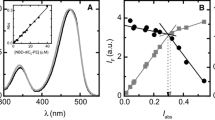Abstract
Purpose: To explore the independence of functional group contributions to permeability of nonelectrolytes across egg lecithin bilayers. Methods. The transport rates were measured of a series of α-substituted p-methylhippuric acids (-H,-Cl,-OCH3,-CN,-OH,-COOH, and-CONH2) across egg lecithin lipid bilayers, in the form of large unilamellar vesicles (LUVs) at 25EC. Intrinsic permeability coefficients (PHA) were calculated from apparent permeability coefficients (Papp) measured as a function of pH. Group contributions to the free energy of transfer from water into the barrier domain, Δ(ΔGE)P,X, were calculated for the substituents and compared to the contributions of these groups when attached to p-toluic acid measured earlier. The Δ(ΔGE)P,X values from permeability data were also correlated with Δ(ΔGE)PC,X values of partitioning from water into organic solvents to determine the physicochemical selectivity of the barrier domain. Results. Papp values in LUVs were found to vary approximately linearly with the fraction of neutral permeant over a pH range of 5.5 to 10.5, suggesting that the transport of the ionized species is negligible over this pH range. The Δ(ΔGE)P,X values from the 2 series of compounds appear to be the same, indicating that the functional group contributions are independent. 1,9-Decadiene was found to be the most similar to the chemical environment of the barrier domain. Conclusions. Functional group contributions to transport across egg lecithin bilayers appear to be independent of the compound to which they are attached, even though the thickness of the barrier domain in lipid bilayers is approximately the same as the extended length of the permeant.
Similar content being viewed by others

References
Dill KA. Additivity principles in biochemistry. J Biol Chem. 1997;272:701–704.
Langmuir I. The distribution and orientation of molecules. In: Holmes HN, ed. Colloid Symposium Monograph. New York: The Chemical Catalog Company; 1925:48–75.
Benson SW. Thermochemical Kinetics: Methods for Estimation of Thermochemical Data and Rate Parameters. New York: Wiley, 1976.
Davis SS, Higuchi T, Rytting JH. Determination of thermodynamics of the methylene group in solutions of drug molecules. J Pharm Pharmacol. 1972;24(suppl):30P-46P.
Rytting JH, Huston LP, Higuchi T. Thermodynamic group contributions for hydroxyl, amino, and methylene groups J Pharm Sci. 1978;67:615–618.
Leo AJ. Calculating log Poct from structures. Chem Rev. 1993;93:1281–1306.
Xiang T-X, Anderson BD. The relationship between permeant size and permeability in lipid bilayer membranes. J Membr Biol. 1994;140:111–121.
Diamond JM, Katz Y. Interpretation of nonelectrolyte partition coefficients between dimyristoyl lecithin and water. J Membrane Biol. 1974;17:121–154.
Xiang T-X, Anderson BD. Substituent contributions to the permeability of substituted p-toluic acids in lipid bilayer membranes. J Pharm Sci. 1994;83:1511–1518.
Leo A, Hansch C, Elkins D. Partition, coefficients and their uses. Chem Rev. 1971;71:525–616.
Xiang T-X, Xu Y-H, Anderson BD. The barrier domain for solute permeation varies with lipid bilayer phase structure. J Membrane Biol. 1998;165:77–90.
Xiang T-X, Anderson BD. Influence of a transmembrane protein on the permeability of small molecules across lipid membranes. J Membr Biol. 2000; in press.
Stockton GW, Smith ICP. A deuterium nuclear magnetic resonance study of the condensing effect of cholesterol on egg phosphatidylcholine bilayer membranes. Chem Phys Lipids. 1976;17:251–263.
Xiang T-X, Chen X, Anderson BD. Transport methods for probing the barrier domain of lipid bilayer membranes. Biophys J. 1992;63:78–88.
Lichtenberg D, Schmidt CF. Molecular packing and stability in the gel phase of curved phosphatidylcholine vesicles. Lipids. 1981;16:555–557.
Ross M, Hildebrand JH. Diffusion of hydrogen, deuterium, nitrogen, argon, methane and carbon tetrafluoride in carbon tetrachloride. J Chem Phys. 1964;40:2397–2399.
Xiang T-X, Anderson BD. Influence of chain ordering on the selectivity of dipalmitoylphosphatidylcholine bilayer membranes for permeant size and shape. Biophys J. 1998;75:2658–2671.
Fettiplace R, Andrews DM, Haydon DA. The thickness, composition and structure of some lipid bilayers and natural membranes. J Membrane Biol. 1971;5:277–296.
Schindler H, Seelig J. Deuterium order parameters in relation to thermodynamic properties of a phospholipid bilayer. A statistical mechanical interpretation. Biochemistry. 1975;14:2283–2287.
Lafleur M, Cullis PR, Bloom M. Modulation of the orientational order profile of the lipid acyl chain in the Lα phase. Eur Biophys J. 1990;19:55–62.
Burton PS, Conradi RA, Ho NFH, Hilgers AR, Borchardt RT. How structural features influence the biomembrane permeability of peptides. J Pharm Sci. 1996;85:1336–1340.
Chikhale EG, Ng K-Y, Burton PS, Borchardt RT. Hydrogen bonding potential as a determinant of the in vitro and in situ blood-brain barrier permeability of peptides. Pharm Res. 1994;11:412–419.
Author information
Authors and Affiliations
Corresponding author
Additional information
published May 3, 2000
Rights and permissions
About this article
Cite this article
Mayer, P.T., Xiang, TX. & Anderson, B.D. Independence of substituent contributions to the transport of small-molecule permeants in lipid bilayer. AAPS PharmSci 2, 14 (2000). https://doi.org/10.1208/ps020214
Received:
Accepted:
Published:
DOI: https://doi.org/10.1208/ps020214



